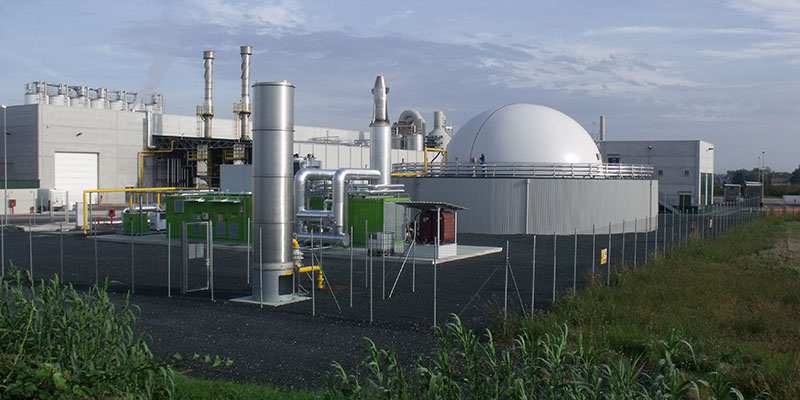
Successfully implementing a waste-to-energy project with anaerobic digestion can feel like an overwhelming process, but the experts at Fluence are ready to help you succeed.
Fluence can help you overcome technical, financial, and regulatory challenges to get the job done
If you’re considering whether a waste-to-energy project makes sense for your wastewater treatment requirements, it’s important to weigh the pros and cons. Waste-to-energy in the form of anaerobic digestion offers some significant benefits.
For example, anaerobic digestion:
- Generates renewable energy in the form of biogas
- Generates valuable byproducts like fertilizer
- Facilitates the recovery of valuable resources such as organic matter, nutrients, and water
- Creates discharges with high agronomic value and suitable for land application
- Reduces sludge production, diverting organic waste from landfills
- Reduces greenhouse gas emissions
- Reduces pollution of waterways
- Promotes the conservation of water resources through water reuse
However, implementing a waste-to-energy project can present unique challenges. What are some of these hurdles, and what are some strategies for overcoming them?
Navigating the Regulatory Landscape
Overcoming regulatory and permitting challenges is critical for the successful implementation of waste-to-energy projects. Addressing these challenges requires engaging with regulatory agencies early in the project development process to understand the regulatory requirements, permitting processes, and potential challenges that may arise.
For help in navigating complex permitting requirements and to avoid potential issues, it is advisable to seek guidance from regulatory compliance experts, legal counsel, and environmental consultants with experience in permitting waste-to-energy projects. These may include air permitting, disposal mechanisms, and discharge permitting review. Fluence can assist with each step and provide solutions to meet stringent discharge requirements.
Addressing Environmental Concerns
Waste-to-energy projects offer significant environmental benefits, including on-site production of renewable energy in the form of biogas, which can lead to a reduction of a company’s carbon footprint. Additionally, enterprises can access incentives while enhancing the value of products that would otherwise be costly to dispose of.
It is equally important to understand the full treatment picture within waste-to-energy projects. While anaerobic digestion has tremendous impact on organic matter, considerations must be made for other contaminants such as sulphur, nitrogen, and other nutrients. Implementing effective secondary treatment technologies is equally as important as generating biogas. Fluence provides the total treatment profile, from digester through treatment of digestates.
Anaerobic digestion produces lower greenhouse gas emissions than traditional waste disposal methods. Methane capture, holding, and treatment are also critical steps in a successful waste-to-energy project. Fluence provides a complete protocol for the collection and transport of biomethane including biogas holding and standby emergency flare systems. With biogas upgrading systems, captured methane can be used as a renewable energy source, producing biomethane for injection into the natural gas grid or for use as transportation fuel.
Optimizing Energy Recovery
Central to waste-to-energy projects is the efficient conversion of organic waste into renewable energy sources, such as biogas and thermal energy. Fluence offers a suite of advanced anaerobic digestion technologies that enable the on-site production of biogas while reducing waste volumes and carbon footprints. Our anaerobic digestion systems are tailored to the specific characteristics of diverse organic waste streams, including those from meat and fish processing, dairy production, fruit processing, brewing, and paper and pulp processing. Through meticulous process optimization and the integration of innovative digestion technologies, we maximize energy recovery potential and enhance the economic viability of waste-to-energy projects.
Mitigating Financial Risks
Securing financing for waste-to-energy projects in wastewater treatment facilities can be challenging due to the significant upfront costs and perceived risks associated with such projects. Yet with some strategic planning, this can be overcome.
Before undertaking a waste-to-energy project, it’s imperative to conduct a thorough feasibility study to assess the economic viability of the project, taking into account factors including:
- Feedstock availability and quality
- Capital costs and operating expenses
- Revenue streams
- Potential incentives
- Return on investment
- Risk factors
Once you have this information in hand, you can start looking for potential investors, lenders, and other creative ways to finance your project.
Fluence collaborates with clients to explore a range of financing options, including public-private partnerships, project finance, and innovative financing mechanisms.
Public-private partnerships facilitate collaboration between private-sector investors, developers, and infrastructure funds to share project risks, responsibilities, and financial resources.
Fluence works with financial institutions, investment banks, and specialized financing agencies to structure financing packages tailored to the unique requirements of waste-to-energy projects in wastewater treatment facilities. Fluence’s financing options include trade financing, as well as rental, lease, and build-own-operate packages to help you get your waste-to-energy project off the ground.
We offer project engineering and evaluation services in which a Fluence expert visits your site to assess the options and provide a recommendation for a profitable waste-to-energy set up. Contact Fluence to learn more about our waste-to-energy solutions and how we can help you overcome some of the common challenges associated with implementing such a project.
